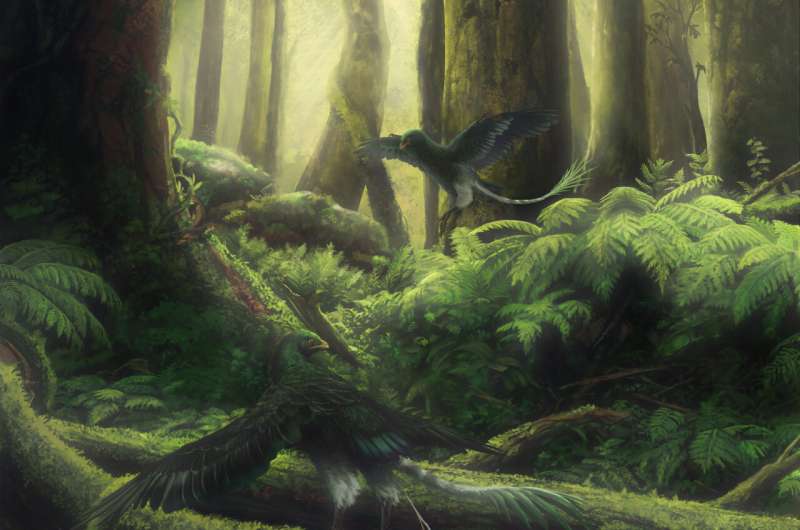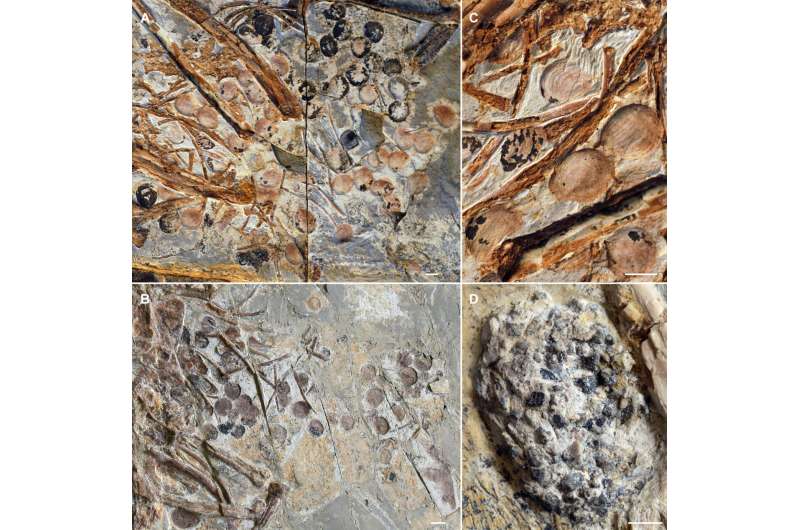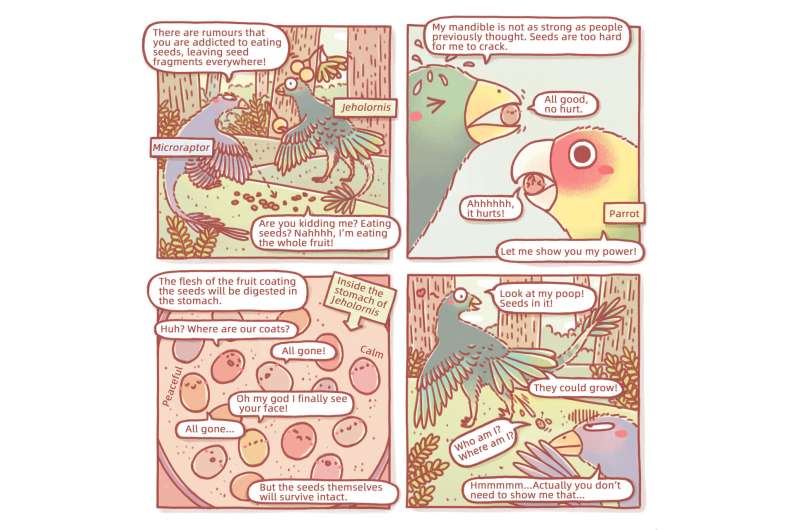
Hundreds of animals eat fruit, from toucans to fruit bats to maned wolves to humans. But most fruit-bearing plants evolved relatively recently in Earth's history, showing up for the first time in the Cretaceous, the final period of the dinosaurs. In a new paper in eLife, scientists have tracked down the first fossil evidence of fruit consumption by comparing the skull shapes and stomach contents of fossil birds. The verdict: the earliest-known fruit-eater was an early bird called Jeholornis that lived 120 million years ago, and it may have helped contribute to the spread of the plants that dominate the world today.
"This is the oldest evidence of fruit-eating in any animal," says Jingmai O'Connor, associate curator of fossil reptiles at the Field Museum in Chicago and co-author of the new eLife paper. "Fruits are an incredible resource that everybody's familiar with, and the plants that produce them are everywhere, but it wasn't always that way. This discovery about how and when birds started exploiting this resource could help explain why these kinds of plants are so dominant in our landscape today."
"Birds are important consumers of fruit today, and play important roles in seed dispersal, but so far there has not been direct evidence of fruit consumption by early birds, outside the bird crown group," says Han Hu, a researcher at Oxford University and the study's first author. "This obstructs our understanding of the origins of this important plant-animal interaction."
The crown group of birds is the group that's alive today, Neornithes, and their direct ancestors. But other birds began evolving tens of millions of years earlier; the second-most primitive known bird was a long-tailed raven-sized creature called Jeholornis. The time between the first Jeholornis and the first T. rex is about the same as the amount of time separating the last T. rex and modern humans.

"The first Jeholornis fossil that was described in 2002 has all these plant remains scattered around it, they look like they exploded out of the stomach cavity," says O'Connor. "These stomach contents were superficially identified as seeds, so people argued that it was eating seeds. Then 17 years later, other scientists suggested that it wasn't just eating seeds, but whole fruits, and only the seeds preserved, since they're harder. In this study, we wanted to figure out, was it feeding on seeds alone, or was it eating fruit?"
"Clarifying between these two hypotheses is important since fruit consumption could result in co-evolutionary mutualism, whereas seed consumption does not," says Hu—eating fruit and pooping out uncrushed seeds could help plants spread and evolve, but if the seeds were crushed up and digested, that wouldn't help the plants.
Solving this mystery required Hu to examine dozens of Jeholornis specimens at China's Shandong Tianyu Museum of Nature. She selected the one with the best-preserved skull and scanned it at the Australian Nuclear Science and Technology Organization's (ANSTO) Australian Synchrotron, Melbourne, Australia..
The scan revealed that Jeholornis's skull has many traits that are more like a dinosaur than a modern bird (modern birds are the only surviving group of dinosaurs). However, the skull did have some traits in its mouth and beak, like reduced teeth, that are present in modern birds—features that could potentially hint at a "modern" diet that included fruit.

After comparing this reconstructed skull of Jeholornis to the skulls—especially the mandibles—of modern birds, including species that grind seeds; species that crack seeds; and species that eat fruits, leaving the seeds whole, the analyses ruled out seed cracking.
However, O'Connor says, "You're not actually going to be able to tell different diets apart from just the mandible shape." But other parts of the fossils could provide additional clues. "Birds that eat seeds have a gastric mill, a gizzard," says O'Connor. "They swallow stones to help them crush up their food."
Some specimens of Jeholornis have been found with gizzard stones, and some have been found with preserved seeds in their gut, but no one's found a Jerholornis with both gizzard stones and seeds at same time. What's more, the seeds found in Jeholornis stomach cavities are whole, not crushed.
These findings suggest that Jeholonis was eating different foods at different times of the year. When fruit was available, it would have eaten whole fruits, seeds and all, and then pooped out the uncrushed seeds. When fruit wasn't in season, it would have eaten something different—and harder—and relied on a gizzard to crush them up. The Jeholornis specimens with whole seeds in their stomachs must have died during fruit season.
This seasonal diet lines up with a trait present in many modern birds. "Birds can drastically change the proportions of their digestive system to adapt to whatever their diet is for a particular season," says O'Connor. "This is the first evidence of that plasticity in dinosaurs."
Not only was Jeholornis the first-known fruit-eater, but it gives scientists a window into how birds helped fruit-producing plants evolve. "Birds may have been recruited for seed dispersal during their earliest evolutionary stages," says Hu. "As highly-mobile seed dispersers, early frugivorous birds might therefore indicate a potential role of bird-plant interactions during the Cretaceous Terrestrial Revolution," in which angiosperm plants start to take over the world. Birds eating fruit and pooping out seeds far away from the parent plant can help fruit-bearing plants spread like wildfire; this pattern may have started with birds like Jeholornis.
Jeholornis's fruit-eating also dovetails with its traits that would have helped it fly, including a long tail that could have worked like a rudder to stabilize it in flight. "A diet of fruit might have put evolutionary pressure on Jeholornis to be better at flying," says O'Connor. "You can't just sit in one tree forever and eat its fruits, you have to be able to move around, and identify those resources by flying up and seeing where they are."
Hu says that she hopes "our research will inspire the research of paleontologists, ecologists, zoologists, and botanists who are interested in bird ecology, trophic interactions, and the Cretaceous Terrestrial Revolution. It is also a flagship of applying multiple cutting-edge methods simultaneously to solve complex paleoecological questions, which will inspire the future researchers to conduct similar analyses to reveal the extinct animals' ecologies."
Explore further
Citation: The early bird gets the fruit: Fossil provides earliest evidence of fruit-eating by any animal (2022, August 16) retrieved 16 August 2022 from https://ift.tt/16hbVFQ
This document is subject to copyright. Apart from any fair dealing for the purpose of private study or research, no part may be reproduced without the written permission. The content is provided for information purposes only.
"fruit" - Google News
August 17, 2022 at 04:04AM
https://ift.tt/16hbVFQ
The early bird gets the fruit: Fossil provides earliest evidence of fruit-eating by any animal - Phys.org
"fruit" - Google News
https://ift.tt/uMdp9jO
https://ift.tt/o4uBXaZ
Bagikan Berita Ini














0 Response to "The early bird gets the fruit: Fossil provides earliest evidence of fruit-eating by any animal - Phys.org"
Post a Comment